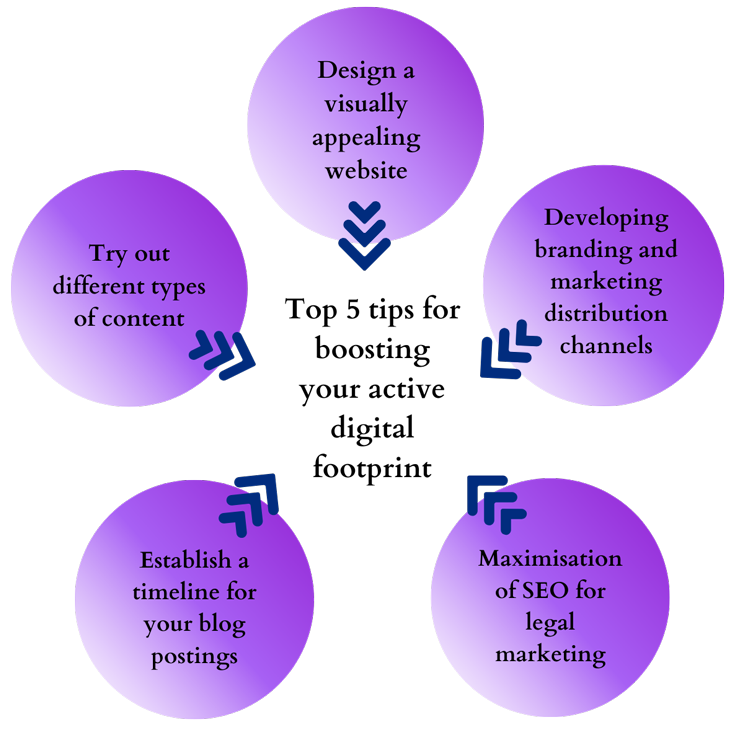
If someone were to mention the word “Rolex” to you, what would be the first thing that comes to your mind?
Luxury, stylish and high-quality watches. That’s the Rolex ‘brand’.
Creating a distinctive brand takes time and effort. Successful firms are aware that investing time and energy into cultivating a strong brand identity will be a worthy investment in the long run and cause them to make meaningful choices along the way. This approach forms an integral part of any law firm’s marketing strategy.
Active digital footprint refers to the information that has been deliberately shared by a user on the internet, through websites or social media platforms. A law firm’s website is often a potential client’s first insight into the firm, hence forming a key part of your firm’s digital footprint. The importance of an optimised website that appeals and holds the attention of its visitors cannot be undermined.
OUR TOP 5 TIPS FOR BOOSTING YOUR DIGITAL FOOTPRINT

A good active digital footprint can help potential clients find your law firm; raise awareness about your expertise and services; create a positive industry reputation; bring in networking and industry collaboration opportunities; and do wonders for business development. Digital footprint mainly consists of two elements – your website and social media pages. In this piece, we will discuss ways to optimise your law firm website for boosting your digital footprint.
A website is a big part of your firm’s overall brand identity. Here are our top 5 tips to ensure your website reflects and brings attention to your law firm.
Design a visually appealing website
What do law firms have to do with ‘aesthetics,’ you ask? Building a trustworthy and reputable brand for your legal practise is made easier if you carefully consider design decisions, visual aspects, and visual branding. If these elements are incorporated into your website’s design in an engaging and attractive manner, it will help you differentiate from the other competitors.
Once you have determined what your brand is, the next step is to determine how it will appear to clients. Want to know more about the visual aspects of branding for law firms? Read our article here!
Maximisation of SEO for legal marketing
Your search engine ranking can make or break your law practise if you want to grow your clientele through website and other digital marketing channels. Understanding how search engine optimisation (SEO) factors into page rank is a worthwhile investment of your time.
Google’s algorithms rank websites with high-quality content, page speed, page experience and backlinks to the top of the page. This helps Google users find what they’re looking for faster. When you optimise your law firm’s website in a way that achieves a higher search engine ranking, you improve both the quality and the quantity of the traffic you receive.
When it comes to designing websites, content and visual appeal play an equally important role. Ensure that your website contains essential pages, such as “About us,” “Services,” and “Contact.”
Going further into optimising your website for search engines, consider creating a blog section or posting regular news updates, such as press releases or updates on client service. Blogging on a consistent basis is not just an excellent strategy to improve the search engine compatibility of your website; but it can also give your content marketing efforts a boost.
Try out different types of content
Blog posts aren’t the sole option for legal content marketing. In fact, you should try out a variety of content formats to find out what your target audience prefers. Incorporating a range of content makes your website more engaging and caters to different kinds of audience.
Consider the following content types for your law firm website – blog posts, interviews, videos, webinars, podcasts, infographics, courses, resource guides, presentations, whitepapers, etc. Click here so that you do not miss on the types of content required to build an effective marketing for law firms!
Establish a timeline for your blog postings
The publication of high-quality material is more vital than the publication of a large number of blog posts each month. Nonetheless, it is still recommended that you develop a blogging schedule to ensure that you can remain consistent. Even if you can only manage to publish one article a month and a handful of social media updates a week, that’s a good place to begin. You will get more proficient at content generation and scheduling posts with time, allowing you to reach a larger audience on a consistent basis. Remember, the more consistently you post about topics involving optimised keywords, the higher your website is likely to rank.
Developing branding and marketing distribution channels
You’ve created your content and uploaded it to your website. What do you do now?
A distribution strategy is an essential part of any successful content marketing approach. How often, where, and how you want to share your content are all aspects of this. Automating the distribution of your material across many social media platforms is made easier with the aid of content sharing solutions. Let’s suppose you upload blogs on your website on a regular basis. It would save a lot of work if you could have them published on all your social media profiles automatically rather than having to manually plan and publish it. Tools like Sprout Social, Airtable, and Levuro, to name a few, can do this for you!
Do you also want to know how to master social media for maximum impact? We have got you covered! Read our previous article here.
NEED ASSISTANCE IN EXECUTING THESE TIPS?
Developing a reputable name for your legal practice requires constant commitment, thorough deliberation, and a comprehensive plan. Your website plays a key role in how potential clients and other visitors see your law firm. As a lawyer running a legal practice, you might not have the energy to spare for developing a website that justifies your exceptional legal services. Good news is, we are here to help you out! Get in touch with us to know more.
Disclaimer: The brands mentioned in the article are only for reference purposes and are not any form of placement/promotion/recommendation.








